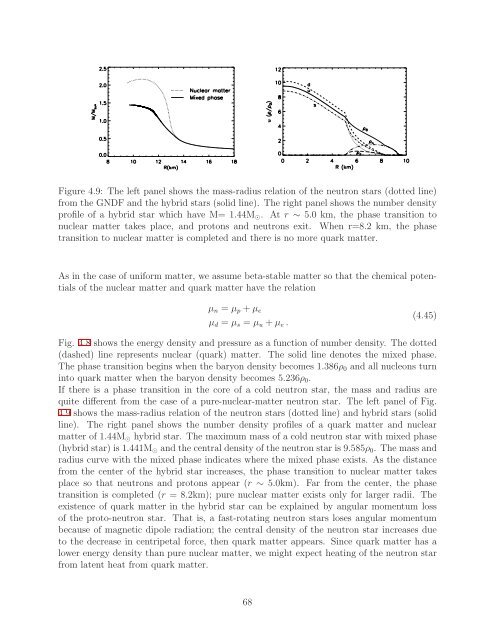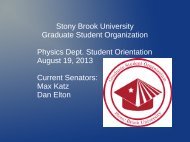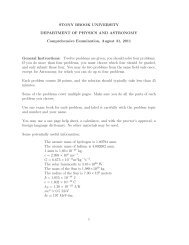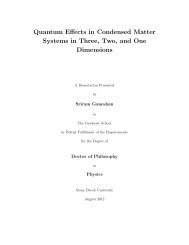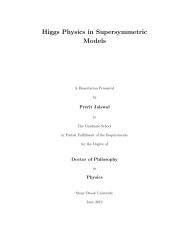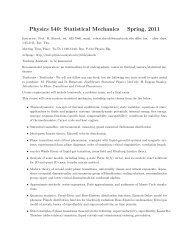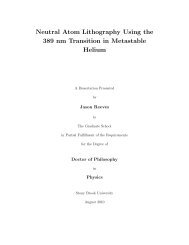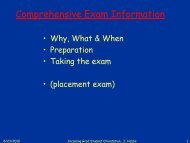Theory of Nuclear Matter for Neutron Stars and ... - Graduate Physics
Theory of Nuclear Matter for Neutron Stars and ... - Graduate Physics
Theory of Nuclear Matter for Neutron Stars and ... - Graduate Physics
You also want an ePaper? Increase the reach of your titles
YUMPU automatically turns print PDFs into web optimized ePapers that Google loves.
Figure 4.9: The left panel shows the mass-radius relation <strong>of</strong> the neutron stars (dotted line)from the GNDF <strong>and</strong> the hybrid stars (solid line). The right panel shows the number densitypr<strong>of</strong>ile <strong>of</strong> a hybrid star which have M= 1.44M ⊙ . At r ∼ 5.0 km, the phase transition tonuclear matter takes place, <strong>and</strong> protons <strong>and</strong> neutrons exit. When r=8.2 km, the phasetransition to nuclear matter is completed <strong>and</strong> there is no more quark matter.As in the case <strong>of</strong> uni<strong>for</strong>m matter, we assume beta-stable matter so that the chemical potentials<strong>of</strong> the nuclear matter <strong>and</strong> quark matter have the relationµ n = µ p +µ eµ d = µ s = µ u +µ e .(4.45)Fig. 4.8 shows the energy density <strong>and</strong> pressure as a function <strong>of</strong> number density. The dotted(dashed) line represents nuclear (quark) matter. The solid line denotes the mixed phase.The phase transition begins when the baryon density becomes 1.386ρ 0 <strong>and</strong> all nucleons turninto quark matter when the baryon density becomes 5.236ρ 0 .If there is a phase transition in the core <strong>of</strong> a cold neutron star, the mass <strong>and</strong> radius arequite different from the case <strong>of</strong> a pure-nuclear-matter neutron star. The left panel <strong>of</strong> Fig.4.9 shows the mass-radius relation <strong>of</strong> the neutron stars (dotted line) <strong>and</strong> hybrid stars (solidline). The right panel shows the number density pr<strong>of</strong>iles <strong>of</strong> a quark matter <strong>and</strong> nuclearmatter <strong>of</strong> 1.44M ⊙ hybrid star. The maximum mass <strong>of</strong> a cold neutron star with mixed phase(hybrid star) is1.441M ⊙ <strong>and</strong>the central density <strong>of</strong> theneutron star is 9.585ρ 0 . The mass <strong>and</strong>radius curve with the mixed phase indicates where the mixed phase exists. As the distancefrom the center <strong>of</strong> the hybrid star increases, the phase transition to nuclear matter takesplace so that neutrons <strong>and</strong> protons appear (r ∼ 5.0km). Far from the center, the phasetransition is completed (r = 8.2km); pure nuclear matter exists only <strong>for</strong> larger radii. Theexistence <strong>of</strong> quark matter in the hybrid star can be explained by angular momentum loss<strong>of</strong> the proto-neutron star. That is, a fast-rotating neutron stars loses angular momentumbecause <strong>of</strong> magnetic dipole radiation; the central density <strong>of</strong> the neutron star increases dueto the decrease in centripetal <strong>for</strong>ce, then quark matter appears. Since quark matter has alower energy density than pure nuclear matter, we might expect heating <strong>of</strong> the neutron starfrom latent heat from quark matter.68


